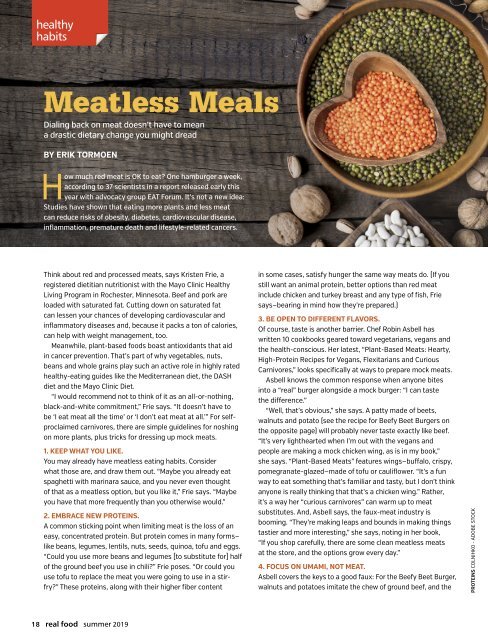Real Food Summer 2019
You also want an ePaper? Increase the reach of your titles
YUMPU automatically turns print PDFs into web optimized ePapers that Google loves.
healthy<br />
habits<br />
Meatless Meals<br />
Dialing back on meat doesn’t have to mean<br />
a drastic dietary change you might dread<br />
BY ERIK TORMOEN<br />
How much red meat is OK to eat? One hamburger a week,<br />
according to 37 scientists in a report released early this<br />
year with advocacy group EAT Forum. It’s not a new idea:<br />
Studies have shown that eating more plants and less meat<br />
can reduce risks of obesity, diabetes, cardiovascular disease,<br />
inflammation, premature death and lifestyle-related cancers.<br />
Think about red and processed meats, says Kristen Frie, a<br />
registered dietitian nutritionist with the Mayo Clinic Healthy<br />
Living Program in Rochester, Minnesota. Beef and pork are<br />
loaded with saturated fat. Cutting down on saturated fat<br />
can lessen your chances of developing cardiovascular and<br />
inflammatory diseases and, because it packs a ton of calories,<br />
can help with weight management, too.<br />
Meanwhile, plant-based foods boast antioxidants that aid<br />
in cancer prevention. That’s part of why vegetables, nuts,<br />
beans and whole grains play such an active role in highly rated<br />
healthy-eating guides like the Mediterranean diet, the DASH<br />
diet and the Mayo Clinic Diet.<br />
“I would recommend not to think of it as an all-or-nothing,<br />
black-and-white commitment,” Frie says. “It doesn’t have to<br />
be ‘I eat meat all the time’ or ‘I don’t eat meat at all.’” For selfproclaimed<br />
carnivores, there are simple guidelines for noshing<br />
on more plants, plus tricks for dressing up mock meats.<br />
1. KEEP WHAT YOU LIKE.<br />
You may already have meatless eating habits. Consider<br />
what those are, and draw them out. “Maybe you already eat<br />
spaghetti with marinara sauce, and you never even thought<br />
of that as a meatless option, but you like it,” Frie says. “Maybe<br />
you have that more frequently than you otherwise would.”<br />
2. EMBRACE NEW PROTEINS.<br />
A common sticking point when limiting meat is the loss of an<br />
easy, concentrated protein. But protein comes in many forms—<br />
like beans, legumes, lentils, nuts, seeds, quinoa, tofu and eggs.<br />
“Could you use more beans and legumes [to substitute for] half<br />
of the ground beef you use in chili?” Frie poses. “Or could you<br />
use tofu to replace the meat you were going to use in a stirfry?”<br />
These proteins, along with their higher fiber content<br />
in some cases, satisfy hunger the same way meats do. (If you<br />
still want an animal protein, better options than red meat<br />
include chicken and turkey breast and any type of fish, Frie<br />
says—bearing in mind how they’re prepared.)<br />
3. BE OPEN TO DIFFERENT FLAVORS.<br />
Of course, taste is another barrier. Chef Robin Asbell has<br />
written 10 cookbooks geared toward vegetarians, vegans and<br />
the health-conscious. Her latest, “Plant-Based Meats: Hearty,<br />
High-Protein Recipes for Vegans, Flexitarians and Curious<br />
Carnivores,” looks specifically at ways to prepare mock meats.<br />
Asbell knows the common response when anyone bites<br />
into a “real” burger alongside a mock burger: “I can taste<br />
the difference.”<br />
“Well, that’s obvious,” she says. A patty made of beets,<br />
walnuts and potato (see the recipe for Beefy Beet Burgers on<br />
the opposite page) will probably never taste exactly like beef.<br />
“It’s very lighthearted when I’m out with the vegans and<br />
people are making a mock chicken wing, as is in my book,”<br />
she says. “Plant-Based Meats” features wings—buffalo, crispy,<br />
pomegranate-glazed—made of tofu or cauliflower. “It’s a fun<br />
way to eat something that’s familiar and tasty, but I don’t think<br />
anyone is really thinking that that’s a chicken wing.” Rather,<br />
it’s a way her “curious carnivores” can warm up to meat<br />
substitutes. And, Asbell says, the faux-meat industry is<br />
booming. “They’re making leaps and bounds in making things<br />
tastier and more interesting,” she says, noting in her book,<br />
“If you shop carefully, there are some clean meatless meats<br />
at the store, and the options grow every day.”<br />
4. FOCUS ON UMAMI, NOT MEAT.<br />
Asbell covers the keys to a good faux: For the Beefy Beet Burger,<br />
walnuts and potatoes imitate the chew of ground beef, and the<br />
PROTEINS COLNIHKO - ADOBE STOCK<br />
18 real food summer <strong>2019</strong>

















